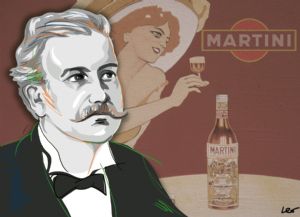Her majesty’s secret servant, James Bond, would certainly not be happy, but I really don’t mind whether they are shaken or stirred, just as long as my martinis are icy cold. The martini’s important ingredient, vermouth-from wermut, German for ‘wormwood,’ a wild plant of the daisy family that has been used since Roman times for its bitter taste-is an aromatic liquor wine. Although Antonio Benedetto Carpano pioneered industrial-scale production of vermouth in Turin, and it is still a specialty of the Piedmont region, the famous cocktail is named, instead, after Alessandro Martini, a Florentine who co-founded the distillery Martini & Rossi and made it popular worldwide.

Of humble origins, Alessandro Martini was born in Florence on May 16, 1834. The family, hoping for a better life, moved to Turin when he was 11. With a family too poor to allow him to continue his studies, Martini, age 14, went to work as a factory boy at a distillery owned by Clemente Michel, Carlo Re, Carlo Agnelli and Eligio Baudino. Along with producing and distributing wine-based spirits for export to France, the company also had a warehouse for rum, absinthe, kirsch, cognac and curaçao. The business prospered and soon opened another distillery in San Salvatore Monferrato, a brewery in Alessandria and a shipping branch in Genoa as well as offices in Bèziers and Narbonne in France.
In 1850, Martini, who had by then been promoted to sales, became a partner in the firm, together with accountant Teofila Sola and distiller and herbalist Luigi Rossi, who developed a new secret recipe for the company’s vermouth, adding to it fragrant fruits and spices that Venetian and Genoese merchants brought home from such places as Crete, Madagascar and Ceylon.
After Carlo Re died in 1860, the business was renamed Martini, Sola & Cia and, in 1864, it opened a new factory in the village of Pessione, close to Turin and with good transport links to the port of Genoa. In fact, the location was ideal for expansion and the company was soon shipping to new markets. In 1865, Martini, Sola & Cia’s vermouth won the Dublin international exhibition, then a universal stamp of quality. This accomplishment was followed by prizes at exhibitions in Paris in 1867 and 1878, Vienna in 1873 and Philadelphia in 1876.

A marketing genius, Martini created a fashion for drinking vermouth among the rich and famous. He was so successful at this that, by 1868, King Vittorio Emanuele II of Savoy allowed the company to put his royal crest on its packaging. Endorsements-conveyed by crests-from King Louis of Portugal, Queen Christina of Austria and Spain, and even the British Parliament soon followed, as were crests of the cities of Melbourne, Antwerp and Mendoza. All these insignia were represented on the bottle’s colorful label.
In 1879, on the death of Teofila Sola, Martini and Luigi Rossi, a truly formidable combination, acquired full control of the enterprise and again changed its name, this time to Martini & Rossi. As the company’s roving ambassador, Martini traveled incessantly. He rapidly augmented exports and opened the first branch office in Buenos Aires in 1884. Through his efforts, by 1903, the beverage was enjoyed in over 70 countries around the world.
A member of the influential Masonic lodge, Martini also found time to participate in Turin’s civic affairs. He was elected a town councilor in 1872 and re-elected in 1895. His entrepreneurial prowess was recognized in 1880 with his nomination as a Commendatore of the Crown of Italy. A member of the board of the Turin branch of the Bank of Italy from 1899 until his death, in 1901 he became one of the first Cavaliere del lavoro of the Kingdom of Italy.
Married twice, Martini had two children, Eligia and Cesarino, with his first wife and another four, Ida, Cesare, Emma and Eligio, with his second. When he passed away on March 14, 1905, Enrico Govean, Martini’s son-in-law (Eligia’s husband), was named executor of his estate. Whilst the reasons are not clear, Govean made what appears to be a controversial decision. He transferred all of the children’s shares in the company, including those of Cesare and Eligio, who were still minors, to Luigi Rossi’s four sons, partners in the firm since their father died in 1892. Although the Martini name remained, this effectively terminated the family’s association with the drink its forebear had helped make legendary.
In 1992, Luigi Rossi’s heirs (by then, the fifth generation) sold Martini & Rossi to the Bacardi family for 1.4 billion U.S. dollars. Today, the newly created Bacardi-Martini group is one of the top 10 alcoholic beverage groups in the world.








